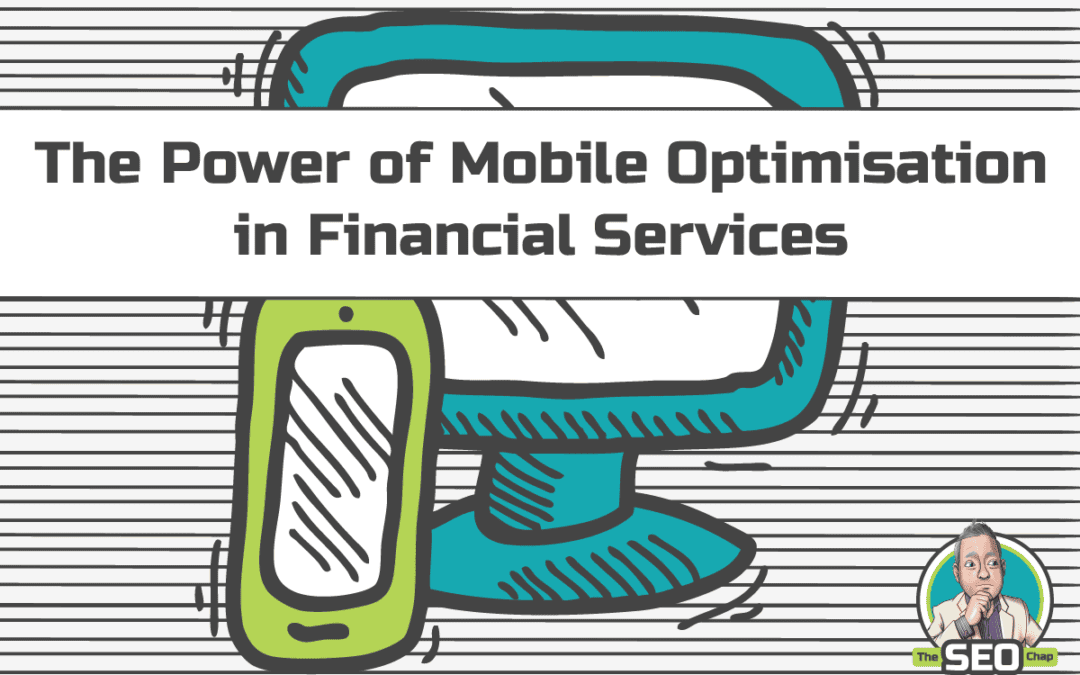
Elevating Financial Services SEO, The Power of Mobile Optimisation
The Importance of Mobile Optimisation in Financial Services SEO, learn why mobile optimisation is crucial for financial services websites to improve search rankings, increase organic traffic, and enhance customer acquisition and retention.
The significance of mobile optimisation for financial services SEO is paramount. As the primary gateway to the internet shifts to mobile devices, financial institutions are faced with the critical task of ensuring their online presence is not only accessible but also optimised for mobile users. This shift is not merely a trend but a fundamental change in how users engage with digital content, making mobile optimisation an essential element for any financial service’s digital strategy. The advent of Google’s mobile-first indexing underscores this reality, where the search giant now prioritises mobile versions of websites for indexing and ranking. This pivotal change highlights the importance of mobile-friendly designs, fast loading speeds, and responsive layouts for financial services websites aiming to maintain or improve their visibility and relevance in search engine results. The implication is clear, without a mobile first optimised website, financial institutions risk falling behind in the fiercely competitive digital landscape, underscoring the urgency for adopting a mobile-first approach in their SEO strategies.
The Impact of Mobile Optimisation on Search Rankings
In today’s digital-first world, Google has placed an unprecedented focus on mobile page speed, marking it as a pivotal ranking factor for websites. This emphasis highlights the critical role of mobile optimisation in the landscape of SEO. Websites that exhibit swift loading times on mobile devices are not only looked upon favourably by Google but also provide a more appealing experience for users. This dual benefit leads to a domino effect, as users engage more deeply and navigate less hastily away from these fast-loading sites, search engines interpret this behaviour as a positive signal. Consequently, such websites experience a noticeable improvement in search rankings. This is particularly relevant for financial service providers, for whom the stakes are high in a competitive digital arena. By prioritising mobile optimisation, these entities can achieve a marked enhancement in their visibility on search engines, thereby attracting a larger share of organic traffic.
The ripple effects of mobile optimisation extend beyond just search rankings. Enhanced user experience on mobile platforms directly influences the retention time on the site, further contributing to SEO success. As financial service providers adapt their websites to meet Google’s mobile-first indexing, they not only cater to the algorithm’s preferences but also align their services with the evolving consumer behaviour patterns. This alignment is essential as the preference for mobile banking and financial transactions continues to rise among consumers. In essence, mobile optimisation acts as a cornerstone for financial services aiming to secure and maintain a prominent position in search engine results pages (SERPs), driving organic traffic and fostering user engagement in a mobile-centric world. For those looking to navigate these waters successfully, partnering with experts like The SEO Chap can provide the specialised knowledge and strategies needed to optimise mobile experiences effectively.

Benefits of Mobile Optimisation in Financial Services
The digital landscape of today’s financial services sector demands more than just a functional website; it requires a mobile-optimised platform that caters to the on-the-go lifestyle of modern consumers. Mobile optimisation in financial services not only boosts SEO performance but also significantly enhances the user experience, leading to higher conversion rates. This is crucial in an industry where the decision to engage with a financial service provider often happens in moments of immediate need or interest. A mobile-optimised website that loads swiftly and presents information in an easily digestible format can be the deciding factor in converting a visitor into a customer.
The journey of mobile optimisation towards fostering customer satisfaction and loyalty is pivotal for financial institutions aiming to secure a stronghold in the competitive market. The enhanced accessibility and convenience of mobile-optimised websites encourage repeat visits and prolonged engagement, essential factors in building a loyal customer base. In addition, the cost-effectiveness of mobile optimisation cannot be overlooked. It provides a sustainable approach to driving organic traffic and improving online visibility without the hefty price tag associated with traditional advertising methods. This strategic investment not only elevates a financial service provider’s SEO performance but also aligns with the evolving consumer preference towards mobile usage, making it an indispensable component of digital marketing strategies in the financial sector.
Key Aspects of Mobile Optimisation
Creating a mobile-optimised environment for financial services websites involves more than just a responsive design; it’s about crafting an intuitive user experience that aligns with the fast-paced lifestyle of today’s consumers. This means implementing responsive layouts that adjust seamlessly across different screen sizes, ensuring that touch-friendly buttons are large enough to interact with without frustration, and simplifying navigation to allow users to find what they need without unnecessary clicks. These elements are not just about aesthetics; they directly contribute to a positive user experience, encouraging longer visit durations and more interactions per visit, which in turn signals to search engines that your site is valuable to users, thus improving your SEO performance.
The speed at which pages load on mobile devices cannot be overstated. Users today expect lightning-fast responses, with delays of even a few seconds leading to increased abandonment rates. This is why optimising for fast loading speeds is essential. Techniques such as compressing images, leveraging browser caching, and minimising the use of heavy scripts can significantly improve load times, keeping users engaged and reducing bounce rates. Additionally, moving away from outdated technologies like Flash and avoiding intrusive pop-ups are critical moves. Flash content is not supported on most mobile devices, and pop-ups can be particularly disruptive on smaller screens, both of which can harm your site’s usability and SEO rankings. By focusing on these key aspects of mobile optimisation, financial services can enhance their online presence, offering an inviting and efficient platform for their users.
The Role of Mobile Optimisation in Customer Acquisition and Retention
In today’s fast-paced digital landscape, the financial sector is witnessing a significant shift towards mobile-first consumer behaviour, making mobile optimisation an indispensable strategy for customer acquisition and retention. Financial institutions that prioritise mobile optimisation for their online services are reaping the benefits through substantially higher engagement levels and conversion rates. This trend underscores the importance of a superior mobile user experience in attracting and securing customers, especially as a growing number of individuals prefer to conduct their financial transactions via mobile apps. For instance, the ease of use and convenience offered by mobile-optimised banking apps have become key factors that influence a user’s decision to choose one financial service provider over another, highlighting the direct correlation between mobile optimisation and customer preference.
By aligning their online services with current consumer trends, such as the increasing reliance on smartphones for banking and financial transactions, institutions not only enhance their appeal among potential clients but also foster loyalty among existing ones. This alignment with consumer preferences is crucial for maintaining competitiveness in the digital banking evolution. Financial services that successfully optimise their online presence for mobile devices are more likely to retain customers, as they meet the expectations for quick, secure, and user-friendly mobile banking experiences. The ongoing preference for app-based transactions further underscores the need for financial services to continually evaluate and improve their mobile optimisation strategies, ensuring they not only attract but also retain a digitally savvy customer base.
Challenges and Solutions in Mobile Optimisation for Financial Services
In financial services, adapting complex tools and calculators for mobile use presents a significant hurdle. These features are indispensable for users looking to make informed financial decisions on the go, yet they often don’t translate well to smaller screens without considerable adjustment. For instance, interactive mortgage calculators must be redesigned to not only fit mobile screens but also remain intuitive for users to navigate with touch controls. This necessitates a blend of innovative design and technology solutions to create mobile-friendly versions that retain full functionality. As financial institutions strive to meet these technical demands, they are also confronted with the challenge of keeping pace with rapidly changing consumer expectations. Today’s mobile users expect seamless and instant access to financial services, compelling providers to constantly refine and enhance their mobile offerings. Regular testing and updates become crucial to ensure that mobile platforms are not just functional but ahead of the curve in terms of speed, convenience, and user engagement.
The issue of mobile security poses a unique challenge. As financial services involve highly sensitive information, ensuring robust security on mobile platforms is non-negotiable. This includes implementing advanced encryption, secure login mechanisms, and fraud detection systems that operate efficiently on mobile devices without compromising user experience. Overcoming these security concerns is essential for building and maintaining customer trust and credibility. Financial institutions must therefore invest in state-of-the-art security measures and regularly update them to protect against emerging threats.
Elevating Financial Services SEO Through Mobile Optimisation
In today’s digital landscape, where the majority of internet traffic comes from mobile devices, mobile optimisation has transcended from being a mere option to an indispensable strategy for financial services. Embracing mobile-friendly designs, ensuring swift page loading, and crafting experiences centred around the mobile user are foundational steps that can propel the SEO performance of financial institutions to new heights. These measures not only cater to the evolving preferences of consumers but also align with Google’s mobile-first indexing, reinforcing the significance of mobile optimisation in improving search rankings and expanding the digital footprint of financial services.

